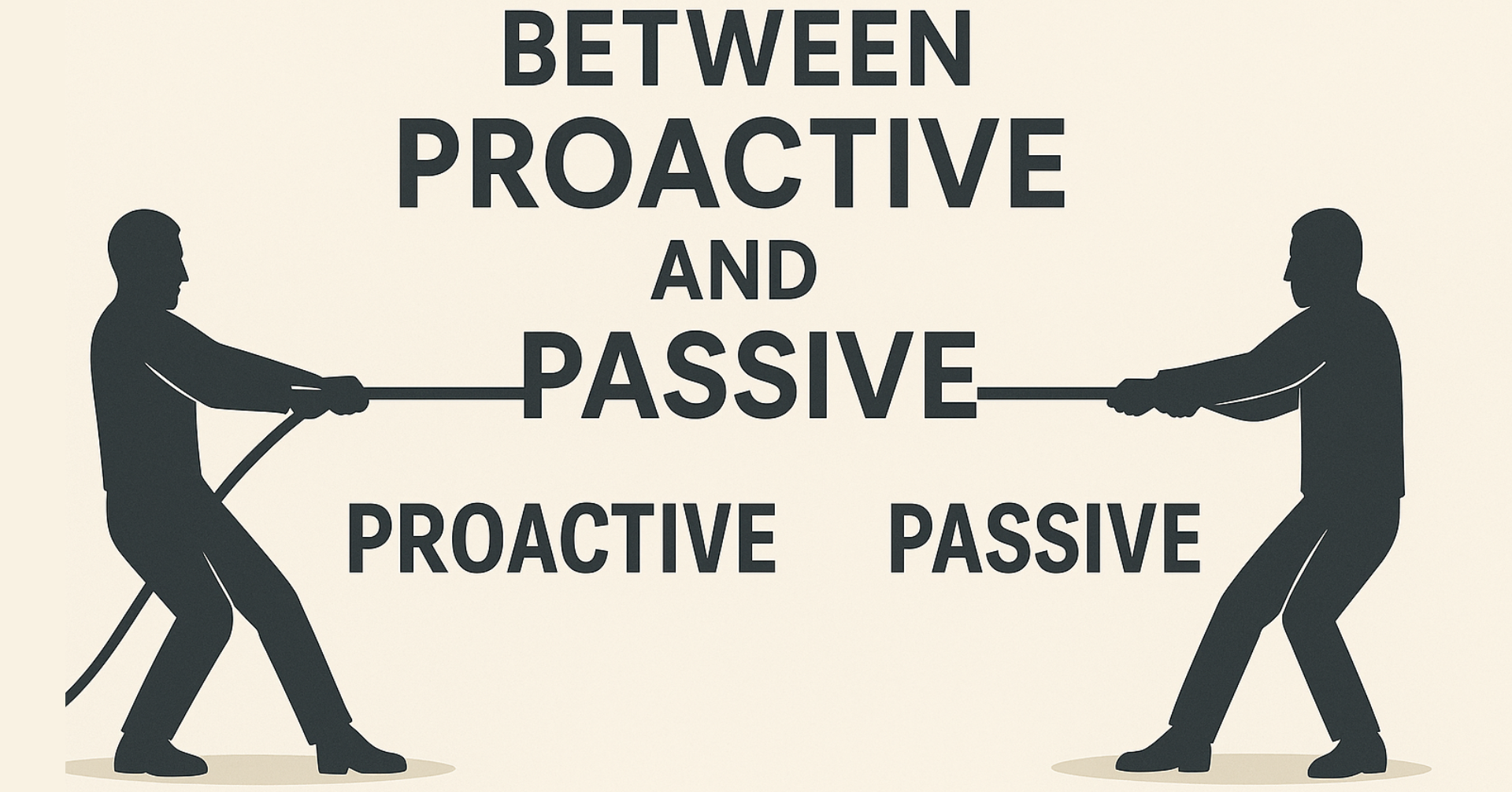
No.0141:Between Proactive and Passive
August 31,2025
Proactive and passive-their meanings stand in opposition. Personally, I tend to associate the former with something positive and the latter with something negative, but the truth isn’t that simple. Each has its merits and drawbacks, which makes the topic all the more intriguing.
Additive vs. Subtractive Scoring ー Two Axes of Evaluation
In organizations, evaluation methods can be seen along two axes: additive scoring (proactive) and subtractive scoring (passive). These aren’t neatly divided into two categories; rather, they form a kind of gradient, pulling against each other in varying degrees. I’ve experienced environments that embodied both extremes.
In additive-scoring organizations, details were often set aside, and roles were entrusted with a fair degree of discretion, which kept motivation high. On the flip side, evaluation (i.e., pay) depended entirely on performance. That gave the system a somewhat dry, transactional edge. Unless you seized as many opportunities as possible, you had little chance to earn credit. I remember those busy, boundaryless days-no clear line between on and off-hectic, but thrilling.
In subtractive-scoring organizations, the focus was on “not failing.” Slogans like “Quality First” were drilled into us like propaganda in an authoritarian state. It was a troublesome place, shadowed by supervisory customs of following detailed instructions and submitting constant reports and requests for approval. In such an environment, the top priority naturally became avoiding tasks that carried any risk of failure. Like a dog sniffing for scraps, people would catch the scent of risk and, if it seemed dangerous, dash away at full speed. That was the survival strategy.
Worse still, smooth-talking opportunists who nitpicked others’ failures and spun eloquent stories about why they shouldn’t take on tasks often gained influence. “Doers lose, critics win.” Unsurprisingly, I never found such an environment comfortable.
Facing Retirement Anxiety ー Proactive and Passive in Investing
Next, let’s talk about investing. A few years ago, the so-called “20 million yen retirement shortfall problem” triggered widespread discussion about preparing for old age through systems like NISA.
Passive funds, especially the global all-country index, have become hugely popular. Passive funds track market averages and tend to carry relatively low risk. Active funds, by contrast, target themes like AI or SDGs, aiming to outperform the market-but with greater risk. In fact, very few active funds consistently beat passive ones over the long term.
That’s why the “safest, least error-prone” strategy is said to be steadily buying passive funds in fixed amounts over the long run. This follows the general principle that while markets fluctuate short term, they tend to rise over time. It’s a way to grow assets while minimizing failure-much like the Showa-era salaryman who, despite hardships, secured a relatively comfortable life by sticking with a company under lifetime employment and seniority-based pay.
America’s Divide ー The Clash of Conservative and Liberal
The tug-of-war between proactive and passive also plays out in American politics. In recent years, conservatism (passive) has made a strong comeback. Advocates of SDGs and similar causes (proactive) are mocked as “woke,” the U.S. equivalent of Japan’s “pseudo-enlightened types.”
Even as scorching summers and climate change become daily reality, the mantra is: forget decarbonization, profits come first-dig up fossil fuels like there’s no tomorrow! Gender, too, is reduced to “biologically male or female only,” with no consideration for the mismatch between body and identity. During the pre-second-Trump era when SDGs were in vogue, I did feel uneasy when male-bodied, female-identified athletes competed in women’s Olympic events. But still, today’s rollback feels extreme.
The rapid push toward “new correctness” likely triggered this fierce backlash. Over time, after much back-and-forth, I expect things will settle into balance-like a pendulum, swinging left and right, gradually losing amplitude until it finds its center.
Too much proactiveness, even if correct, invites furious resistance.
Two Values in IT
Finally, my fieldーIT. There’s the ongoing task of continuously updating completed apps, and the challenge of creating something entirely new. Both carry their own rewards and difficulties.
The former requires working within an established framework, which often forces a passive stance. The latter allows more freedom and proactive creativity, but carries a higher risk of rejection by users.
What both share is the importance of discerning and proposing latent customer needs-even ones customers themselves haven’t fully realized-and inspiring them. For example, when I work with clients, I aim to exceed their expectations. That means not only speed and quality but also offering alternatives that make them say, “That’s great!” I consciously emphasize this proactive stance, even if it risks being seen as overbearing at times.
“A lot of times, people don’t know what they want until you show it to them.”-Steve Jobs
Failure Yields More Value Than Pain
I’ve discussed the merits and drawbacks of proactiveness and passiveness, but in my career, I’ve found “proactive” to be more valuable. Avoiding mistakes through passivity may prevent pain, but repeating mistakes through proactivity offers countless chances to improve-and, in the long run, far greater value.
Occasionally I meet people who are fluent but oddly lacking in depth. In those moments, I wonder: “Maybe this person has developed such strong danger-avoidance skills that they’ve been denied the chance to learn from failure?” To avoid such a fate myself, I remind myself not to stay submerged in the comfort zone.
“It’s not stimulating, but at least I won’t get hurt-peace above all!” That stance feels increasingly unrealistic. Japanese companies’ relative value has plummeted compared to the past, and they can no longer afford to carry surplus staff. Precisely because of this, I want to stay engaged with things that look exciting-even if they might hurt me-pursuing them with curiosity and a racing heart.
“The world breaks everyone, and afterward, many are strong at the broken places.”-Ernest Hemingway, A Farewell to Arms
Why not step just a little outside your comfort zone?


